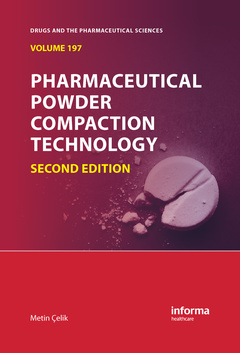Description
Pharmaceutical Powder Compaction Technology (2nd Ed.)
Drugs and the Pharmaceutical Sciences Series
Coordinator: Çelik Metin
Language: English
Subject for Pharmaceutical Powder Compaction Technology:
Keywords
Dicalcium Phosphate Dihydrate; Magnesium Stearate; Tablet Press; Tablet Strength; MCC; Compaction Simulator; Moisture Content; A-lactose Monohydrate; Rotary Tablet Press; Single Station Tablet Press; Tablet Properties; Lubricant Sensitivity; Heckel Plots; Strain Gage; Colloidal Silicon Dioxide; Compaction Properties; Compaction Profile; Ejection Force; Multilayer Tablet; Direct Compaction; Lubricant Film; Anhydrous A-lactose; Percolation Threshold; Bilayer Tablet; Amorphous Lactose
Publication date: 03-2021
· 17.8x25.4 cm · Paperback
Publication date: 08-2011
343 p. · 17.8x25.4 cm · Hardback
Description
/li>Contents
/li>Readership
/li>Biography
/li>
Compaction of powder constituents?both active ingredient and excipients?is examined to ensure consistent and reproducible disintegration and dispersion profiles. Revised to reflect modern pharmaceutical compacting techniques, this second edition of Pharmaceutical Powder Compaction Technology guides pharmaceutical engineers, formulation scientists, and product development and quality assurance personnel through the compaction formulation process and application.
This unique reference covers:
- The physical structure of pharmaceutical compacts
- Bonding phenomena that occur during powder compaction
- Compression mechanisms of pharmaceutical particles
- Theories and basic principles of powder compaction
New topics include:
- Compaction data analysis techniques
- The migration of powder constituents into commercial manufacture
- Instrumentation for compaction
- Compaction functionality testing, which is likely to become a USP requirement
- Design space for compaction
- Metrics required for scalability in tablet compression
- Interactive compaction and preformulation database for commonly used excipients
Theory of Compaction: Intermolecular Bonding Forces: where materials and process come together. Compaction Data Analysis Techniques: Viscoelastic Models. Application of Percolation Theory and Fractal Geometry to Tablet Compaction. Post Compaction Data Analysis TechniquesIntrumentation and Equipment in Compaction: Tablet Press Instrumentation in the Research and Development Environment. Advanced Compaction Research Equipment: Compaction Simulators. Compactability Functionality Test. Role of Compaction in the Formulation and Process Development of Tabletting: Compaction Properties of Directly Compressible Materials. Lubrication Issues in Direct Compaction. Crystal Engineering and Particle Design for the Powder Compaction Process. Compaction of Combination Products. Quality by Design and Compression . Expert Systems and Their Use in Pharmaceutical Applications. Press-To-Press Scalability and Transitioning Factors.



